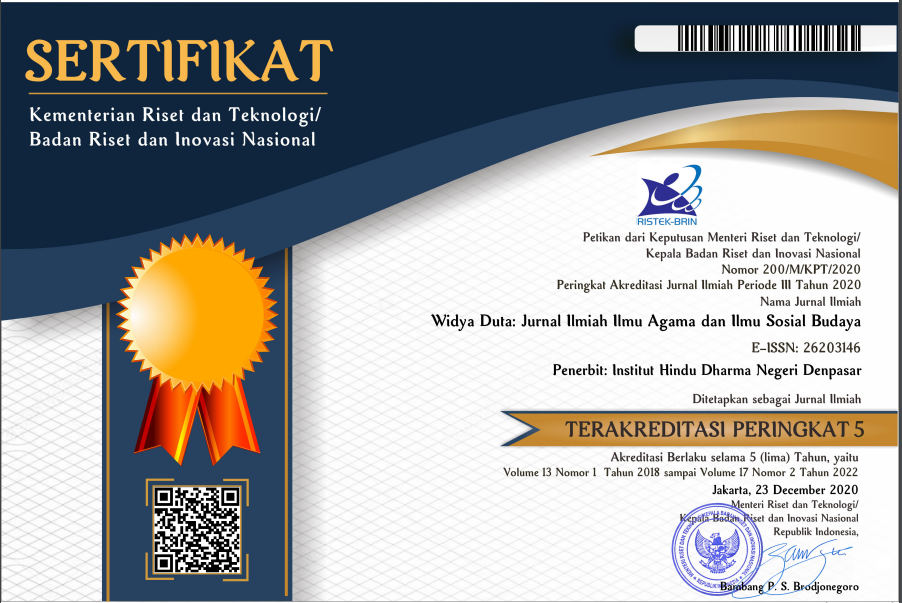PALETASAN SEBAGAI CERMINAN INTERAKSI SOSIAL MASYARAKAT HINDU BALI AGA DI KABUPATEN BANGLI
DOI:
https://doi.org/10.25078/wd.v17i1.846Keywords:
Paletasan, Bali Aga, Social InteractionAbstract
Social interaction, communication, and language certainly cannot be separated from the life of the Balinese people in general, and in particular to the Bali Aga community. The Bali Aga Hindu community has a very large variety of traditions, one of which is very thick and distinctive in the fields of architecture and spatial planning. In the architectural culture and spatial planning of the Bali Aga community, starting from choosing a place to live, it is very full of calculations where the Bali Aga community knows the concept of Ulu Teben. So based on this concept, the Bali Aga community is very selective in determining the area to be their residence. The concept of spatial planning is not only limited to the selection of residential areas, but also involves village development and housing for residents. One thing that is very unique to the people of Bali Aga is the Paletans that are in every resident's house. Paletanan in Balinese has the meaning of other roads, alternative roads, and shortcuts (Gautama, 2009: 385). It is this palette that distinguishes the Balinese Aga community's yard from the Bali Dataran community. In general, in Bali, they recognize the existence of Pamesu as an access road in and out of the Balinese house yard. But in contrast to the Balinese Aga community yard, besides having Pamesu as the main access in and out to the yard, there is also a so-called Paletasan which also functions as a shortcut access to connect the yards to one another.
Oriented to this background, the following problems can be formulated: 1. How is the conception of Paletas as a cultural heritage of the Balinese Hindu community in Bangli Regency?, (2) How is the implementation of the conception of Paletas as a cultural heritage of the Balinese Hindu community in Bangli Regency?, (3 ) What are the implications of Paletasan for the social life of the Balinese Hindu community in Bangli Regency?. In general, this study aims to reveal the meaning behind the existence of Paletan as a cultural heritage of the Bali Aga community which is related to the social interactions of the Balinese Hindu community in Bangli Regency. This research uses structural functional theory, meaning theory, and cultural implication theory. The source of data in this study is a direct source (primary) obtained in the field as a result of observation and scrutiny of Paletasan as a cultural heritage of the Balinese Aga community. Meanwhile, indirect (secondary) sources can be obtained through books, articles, written documents, and so on from libraries or other places. Primary and secondary sources can be combined or cross-checked to obtain truly accurate and accountable data. The informants in this study were determined purposively. The data collection used here includes direct observation on the object of research (observation), interviews, and literature study. After the data is obtained, it is analyzed by reducing it, then presenting the data, and drawing conclusions.
The results of the research can be described as follows: (1) The conception of Paletas as a cultural heritage of the Balinese Hindu community in Bangli Regency at the beginning of its development was identical as an effort to build social interaction in the midst of people's lives. Paletasan functioned as a defense system by the Balinese Aga in its earlier era. Where Bangli, especially in historical times, experienced various kinds of conflicts which were quite tense so that this Paletasan was a reflection of the Bali Aga community in Bangli Regency to defend themselves from conflicts that threatened them from outside. Then, the last one, Paletasan plays a role in maintaining the social ties of the community so that they always respect each other, love each other, and protect each other (sharpening, loving, nurturing seguluk seguluk seguluk seguluk). (2) The implementation of Paletan as a cultural heritage of the Balinese Hindu community in Bangli Regency can of course be viewed from the current existence of Paletasan. Paletasan still exists today in the Bali Aga community, of course, it is based on the understanding that it is a form of cultural heritage from the ancestors of the Bali Aga community. In addition to this, the existence of Paletasan today is driven by the uniformity factor, where as we understand that the Bali Aga community really values togetherness, especially in relation to religious systems, culture, and traditions. Finally, the current implementation of Paletan is also driven by the community's belief that it will have a positive impact on the lives of the Balinese Aga community. (3) The implications of Paletasan on the social life of the Balinese Hindu community in Bangli Regency, of course, cannot be separated from Paletasan's involvement in various social phenomena of the supporting community. In this case Paletasan plays a very important role in mobilizing all forms of community interest so that everything that is done will tend to be more effective and efficient. Besides this, Paletan also has implications for strengthening the social system so that people will always have dependence on each other. And on the other hand, Paletasan is able to provide a feeling of security and comfort to the community that supports it.





